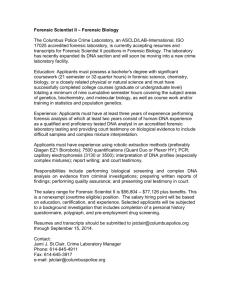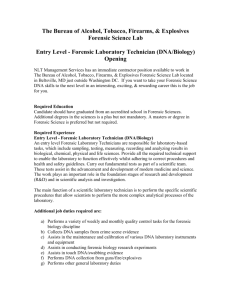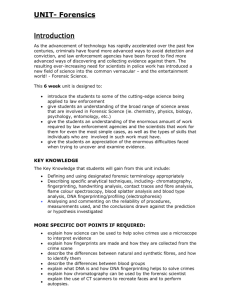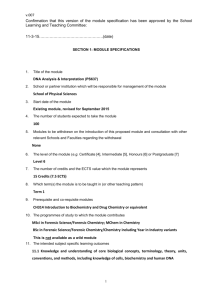101B - American Bar Association
advertisement
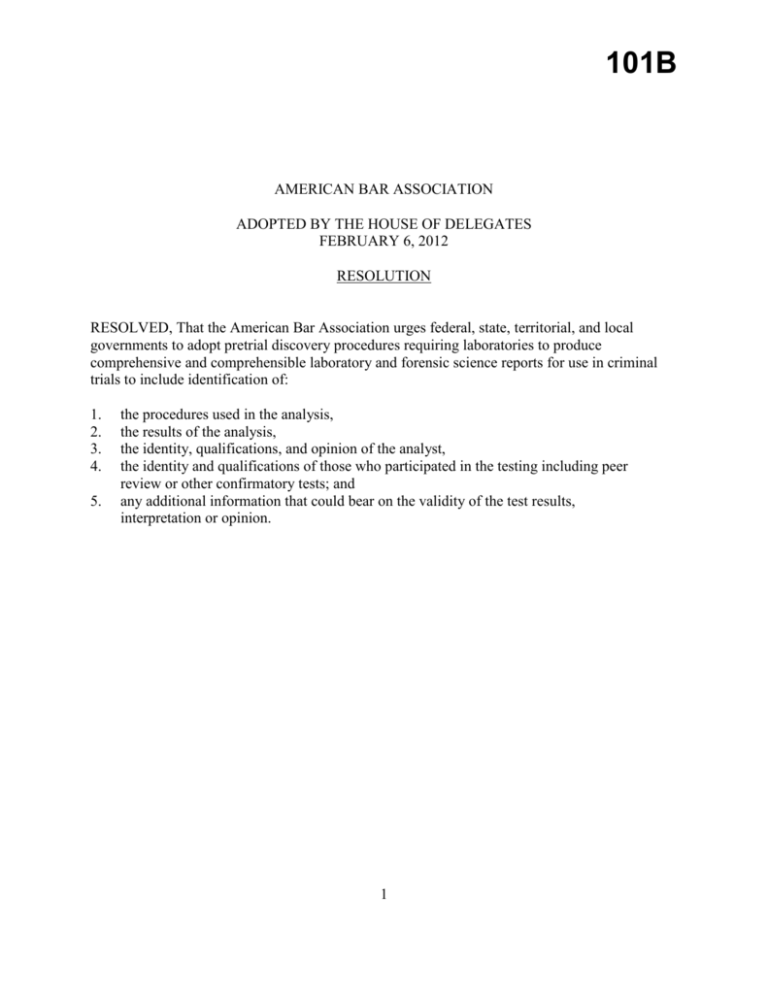
101B AMERICAN BAR ASSOCIATION ADOPTED BY THE HOUSE OF DELEGATES FEBRUARY 6, 2012 RESOLUTION RESOLVED, That the American Bar Association urges federal, state, territorial, and local governments to adopt pretrial discovery procedures requiring laboratories to produce comprehensive and comprehensible laboratory and forensic science reports for use in criminal trials to include identification of: 1. 2. 3. 4. 5. the procedures used in the analysis, the results of the analysis, the identity, qualifications, and opinion of the analyst, the identity and qualifications of those who participated in the testing including peer review or other confirmatory tests; and any additional information that could bear on the validity of the test results, interpretation or opinion. 1 101B REPORT Current ABA Discovery Standards provide for the discovery of expert testimony and scientific reports: Any reports or written statements of experts made in connection with the case, including results of physical or mental examinations and of scientific tests, experiments, or comparisons. With respect to each expert whom the prosecution intends to call as a witness at trial, the prosecutor should also furnish to the defense a curriculum vitae and a written description of the substance of the proposed testimony of the expert, the expert’s opinion, and the underlying basis of that opinion.2 Although this Standard requires the disclosure of laboratory reports, it does not specify the content of the report. In contrast, the DNA Standards go much further and specify the contents of laboratory reports in detail and list types of discoverable materials. See Appendices A and B. This Resolution bridges the gap between the two standards. It applies whenever a lab report is required to be disclosed, including defense reports. Laboratory Reports Virtually all jurisdictions have comparable provisions. For example, Federal Rule 16(a)(1)(F) makes the “results or reports of any physical or mental examination and of any scientific tests or experiments” discoverable. Unfortunately, these rules do not specify the content of a laboratory report. Melendez-Diaz v. Massachusetts3 illustrates the problem. According to the Supreme Court, the laboratory report in that case “contained only the bare-bones statement that ‘[t]he substance was found to contain: Cocaine.’ At the time of trial, petitioner did not know what tests the analysts performed, whether those tests were routine, and whether interpreting their results required the exercise of judgment or the use of skills that the analysts may not have possessed.”4 In contrast, the Civil Rules require that the report must contain: (i) a complete statement of all opinions the expert will express and the basis and reasons for them; (ii) the data or other 1 This resolution was developed by a Forensic Science Task Force whose membership includes: Professor Myrna S. Raeder (Co-chair), Matthew F. Redle (Co-chair), Barry A.J. Fisher (retired lab director), Judge Ronald S. Reinstein, Betty Layne DesPortes, and Professor Paul G. Giannelli. 2 ABA STANDARDS FOR CRIMINAL JUSTICE, DISCOVERY AND TRIAL BY JURY Standard 112.1(a)(iv) (3d ed. 1996). 3 129 S. Ct. 2527 (2009). 4 Id. at 2537 (citation omitted). Melendez-Diaz is important for another reason. The Court appeared to approve at least some types of notice-and-demand statutes. Such statutes require defense counsel demand the presence of the analyst, once notified that the prosecution intends to introduce a laboratory report. Defense counsel, however, cannot intelligently waive the presence of the analyst unless counsel understands details of the analysis. 1 101B information considered by the witness in forming them; (iii) any exhibits that will be used to summarize or support them; (iv) the witness’s qualifications, including a list of all publications authored in the previous ten years; (v) a list of all other cases in which, during the previous four years, the witness testified as an expert at trial or by deposition; and (vi) a statement of the compensation to be paid for the study and testimony in the case.5 The bare-bones reports in criminal cases are a product of the adversary system, not science.6 The Journal of Forensic Sciences, the official publication of the American Academy of Forensic Sciences, published a symposium on the ethical responsibilities of forensic scientists in 1989.7 One article discussed a number of unacceptable laboratory reporting practices, including (1) “preparation of reports containing minimal information in order not to give the ‘other side’ ammunition for cross-examination,” (2) “reporting of findings without an interpretation on the assumption that if an interpretation is required it can be provided from the witness box,” and (3) “[o]mitting some significant point from a report to trap an unsuspecting cross-examiner.”8 These practices could be curbed, if not eliminated, by requiring comprehensive laboratory reports. Comprehensive Reports In general, the report should be sufficiently comprehensive so that an independent expert can identify the process used and the conclusions reached. The commentary to the DNA Standards explains: DAB and CODIS Standards require reports to include (1) a case identifier, (2) a description of evidence examined, (3) a description of the methodology, (4) the locus tested, (5) the results and /or conclusions, (6) an interpretative statement (either quantitative or qualitative), (7) the date issued, (8) the disposition of evidence, and (9) a signature and title, or equivalent identification, of the person(s) accepting responsibility of the content of the reports.9 The commentary goes on to state that: 5 FED. R. CIV. P. 26(a)(2)(B)(i)-(vi). As one scientist has observed: “For a report from a crime laboratory to be deemed competent, I think most scientists would require it to contain a minimum of three elements: (a) a description of the analytical techniques used in the test requested by the government or other party, (b) the quantitative or qualitative results with any appropriate qualifications concerning the degree of certainty surrounding them, and (c) an explanation of any necessary presumptions or inferences that were needed to reach the conclusions.” Professor Anna Harrison, Mount Holyoke College, Symposium on Science and The Rules of Legal Procedure, 101 F.R.D. 599, 632 (1984). 7 Joseph L. Peterson, Symposium: Ethical Conflicts in the Forensic Sciences, 34 J. FORENSIC SCI. 717-93 (1989). 8 Douglas M. Lucas, The Ethical Responsibilities of the Forensic Scientist: Exploring the Limits, 34 J. FORENSIC SCI. 719, 724 (1989). Lucas was the Director, Centre of Forensic Sciences, Ministry of the Solicitor General, Toronto, Ontario. 9 ABA STANDARDS FOR CRIMINAL JUSTICE, DNA EVIDENCE Standard 16-3.3 cmt. at 73. See also DAB Standard 11.1.2 (1998); CODIS Standards for Forensic DNA Testing Laboratories Standards 11.1.2. 6 2 101B ASCLD requires laboratory reports to include (1) an “accurate summary of significant material contained in the case notes,” (2) “interpretive information as well as examination results wherever possible,” and (3) identification of “the analyst(s) and, if appropriate, the testing methodology.”10 The National Academy of Sciences 2009 report on forensic science commented on the issue: As a general matter, laboratory reports generated as the result of a scientific analysis should be complete and thorough. They should contain, at minimum, “methods and materials,” “procedures,” “results,” “conclusions,” and, as appropriate, sources and magnitudes of uncertainty in the procedures and conclusions (e.g., levels of confidence). Some forensic science laboratory reports meet this standard of reporting, but many do not. Some reports contain only identifying and agency information, a brief description of the evidence being submitted, a brief description of the types of analysis requested, and a short statement of the results (e.g., “the greenish, brown plant material in item #1 was identified as marijuana”), and they include no mention of methods or any discussion of measurement uncertainties.11 Comprehensible The National Academies 2004 report on bullet lead noted that “a section of the laboratory report translating the technical conclusions into language that a jury could understand would greatly facilitate the proper use of this evidence in the criminal justice system.”12 The DNA Standards contain a comparable provision. The commentary to Standard 163.3(c) explains: This Standard requires that a section of the laboratory report translate the scientific result into language that a nonscientist would understand. The purpose of forensic DNA testing is to assist the criminal justice system in fulfilling its function to convict the guilty and exonerate the innocent. Accordingly, participants in the system need to understand the significance of the test results. Overworked prosecutors and defense attorneys do not always have time to sort through data in order to appreciate the probative value of the lab analysis. They will, in any case, find a comprehensible summary useful in consulting with and questioning persons with greater expertise than they possess. Jurors may also welcome a written summary that they can understand 10 DNA STANDARDS, supra note 9, at cmt. at 73. RESEARCH COUNCIL, NATIONAL ACADEMY OF SCIENCES, STRENGTHENING FORENSIC SCIENCE IN THE UNITED STATES: THE PATH FORWARD 21 (2009) [hereinafter NAS FORENSIC SCIENCE REPORT] 12 NATIONAL RESEARCH COUNCIL, NATIONAL ACADEMY OF SCIENCES, FORENSIC ANALYSIS: W EIGHING BULLET LEAD EVIDENCE 110-11 (2004) [hereinafter W EIGHING BULLET LEAD EVIDENCE]. 111NATIONAL 3 101B without “translation” by an expert. Nobody is in a better position to summarize the results for the participants than the examiners themselves.13 Additional Information The phrase “any additional information that could bear on the validity of the test results, interpretation or opinion” is taken from the DNA Standard 16-3.3, which governs laboratory reports. This would cover such things as the limitations of the technique. A National Academies 2004 report on bullet lead addressed this issue: “The conclusions in laboratory reports should be expanded to include the limitations of compositional analysis of bullet lead evidence. In particular, a further explanatory comment should accompany the laboratory conclusions to portray the limitations of the evidence. . . Finally, measurement data (means and standard deviations) for all of the crime scene bullets and those deemed to match should be included.”14 The National Academy of Sciences 2009 report on forensic science also addressed this issue. Reports “must include clear characterizations of the limitations of the analyses, including measures of uncertainty in reported results and associated estimated probabilities where possible.”15 Conclusion In addition to due process concerns, comprehensive discovery serves several other purposes. First, by ensuring that the examiner has followed the prescribed procedure and by permitting external review, full discovery is a quality control mechanism. Second, such discovery assists attorneys in preparing for trial and thus render effective representation. Third, defense counsel’s decision to seek appointment of a defense expert often requires a preliminary assessment by an expert. An expert might be willing to offer such an assessment, based upon the information contained in a comprehensive, without compensation. Respectfully submitted, Janet Levine Chair, Criminal Justice Section February 2012 13 14 15 DNA STANDARDS, supra note 9, at Standard 16-3.3(c) cmt. at 75. W EIGHING BULLET LEAD EVIDENCE, supra note 12, at 110-11. NAS FORENSIC SCIENCE REPORT, supra note 11, at 21-22. 4 101B APPENDIX A DNA Evidence Standard 16-3.3 Laboratory reports (a) (b) (c) A summary of all DNA testing and data interpretation should be recorded promptly in a report. The report should be sufficiently comprehensive so that an independent expert can identify the process used and the conclusions reached. Specifically, the report should include: (i) what was tested, (ii) who conducted the testing, (iii) identification of the protocol used in the testing and any deviation from the protocol, (iv) the data and results produced by the testing or data interpretation, (v) the examiner’s interpretation of the results and conclusions therefrom, (vi) the method and results of any statistical computation, and (vii) any additional information that could bear on the validity of the test results, interpretation or opinion. A separate section of the report should explain the test results, interpretation and opinion in language comprehensible to a layperson. APPENDIX B DNA Evidence Standard 16-4.1 Disclosure (a) The prosecutor should be required, within a specified an reasonable time prior to trial, to make available to the defense the following information and material relating to DNA evidence: (i) laboratory reports as provided in Standard 16-3.3; (ii) if different from or not contained in any laboratory report, a written description of the substance of the proposed testimony of each expert, the expert’s opinion, and the underlying basis of that opinion; (iii) the laboratory case file and case notes; (iv) a curriculum vitae for each testifying expert and for each person involved in the testing; (v) the written material specified in Standard 16-3.1(a); (vi) reports of all proficiency examinations of each testifying expert and each person involved in the testing, with further information on proficiency testing discoverable on a showing of particularized need; (vii) the chain of custody documents specified in Standard 16-2.5; (viii) all raw electronic data produced during testing; 5 101B (ix) (b) reports of laboratory contamination and other laboratory problems affecting testing procedures or results relevant to the evaluation of the procedures and test results obtained in the case and corrective actions taken in response; and (x) a list of collected items that there is reason to believe contained DNA evidence but have been destroyed or lost, or have otherwise become unavailable; (xi) material or information within the prosecutor’s possession or control, including laboratory information or material, that would tend to negate the guilt of the defendant or reduce the punishment of the defendant. The defense should be required, within a specified and reasonable time prior to trial, to make available to the prosecution the information and material in subdivision (a)(i) through (ix) of this standard for each expert whose testimony the defense intends to offer. 6 101B GENERAL INFORMATION FORM Submitting Entity: Criminal Justice Section Submitted By: Janet Levine, Chair 1. Summary of Resolution(s). The resolution urges governments at various levels to require laboratories producing reports for use in criminal trial to adopt pretrial discovery procedures requiring comprehensive and comprehensible laboratory and forensic reports that include a number of identified criteria. 2. Approval by Submitting Entity. The resolution was approved by the Criminal Justice Section Council at its October 29, 2011 meeting. 3. Has this or a similar resolution been submitted to the House or Board previously? This resolution fills a gap left by relevant ABA Criminal Justice Standards. See #4, below. 4. What existing Association policies are relevant to this Resolution and how would they be affected by its adoption? The ABA House of Delegates has approved two sets of ABA Criminal Justice Standards with relevant provisions: Discovery (3d edition, approved at the 2004 Annual Meeting) and DNA Evidence (3d edition, approved at the 2006 Annual Meeting. Subsection (a)(iv) of Discovery Standard 11-2.1 on “Prosecutorial Disclosure” provides that the prosecutor should disclose to the defense at a reasonable time prior to trial “any reports or written statements of experts made in connection with the case, including results of physical or mental examinations and of scientific tests, experiments, or comparisons. . . “ DNA Standard 3.3 on “Laboratory reports” requires a comprehensive report of all DNA testing that includes “what was tested, who conducted the testing, identification of the protocol used and any deviation from the protocol, the data and results produced by the testing or data interpretation, the examiner’s interpretation of the results and conclusions, the method and results of any statistical computation, and any additional information that could bear on the validity of the test results. DNA Standard 4.1 on “Disclosure” calls for requiring the prosecutor, within a specified and reasonable time prior to trial, to make the laboratory report and other specified information and material related to DNA evidence available to the defense. 7 101B The proposed resolution fills the gap between the Discovery Standards which are not as specific as the DNA Standards with respect to the contents of the report and the DNA Standards which do not apply to laboratory reports about non-DNA forensic evidence. 5. What urgency exists which requires action at this meeting of the House? The 2009 National Academy of Sciences report, Strengthening Forensic Science in the United States: A Path Forward specifically mentioned that “laboratory reports generated as the result of a scientific analysis should be complete and thorough. They should contain, at minimum, “methods and materials,” “procedures,” “results,” “conclusions,” and, as appropriate, sources and magnitudes of uncertainty in the procedures and conclusions (e.g., levels of confidence).” NAS Report at 21. Given the concerns expressed in the report about the introduction of certain forensic science evidence at trial, adequate discovery is essential for lawyers to be able to appropriately evaluate such evidence. Forensic science evidence has been an issue in a number of the wrongful conviction cases. This resolution closes a gap that currently exists in discovery ABA standards in order to diminish the likelihood of additional wrongful convictions and to better ensure the integrity of forensic evidence presented at trial. 6. Status of Legislation. (If applicable) 7. Brief explanation regarding plans for implementation of the policy, if adopted by the House of Delegates. The resolution and report will be distributed to organizations of judges and lawyers, as well as to forensic science organizations. CLE and media outreach is also contemplated concerning this discovery issue and the related trial issues in the other forensic science resolutions being currently proposed. 8. Cost to the Association. (Both direct and indirect costs) --- No cost to the Association is anticipated. 9. Disclosure of Interest. (If applicable) None. 10. Referrals: Concurrently with the submission of this resolution to the ABA Policy Administration Office for calendaring on the House of Delegates agenda for the 2012 Midyear Meeting, it is being circulated to the chair (or president) and staff director (or executive director) of the following ABA entities and outside organizations: 8 101B Standing Committees Ethics and Professional Responsibility General Practice, Solo and Small Firm Division Governmental Affairs Gun Violence Legal Aid and Indigent Defense Substance Abuse Special Committees and Commissions American Jury Project Bioethics and the Law Death Penalty Representation Project Domestic and Sexual Violence Coalition on Racial and Ethnic Justice Youth at Risk Sections and Divisions Government and Public Sector Lawyers Individual Rights and Responsibilities Judicial Division Litigation National Conference of Federal Trial Judges National Conference of State Trial Judges National Conference of Specialized Court Judges Science and Technology Law State and Local Government Law Young Lawyers Division 11. Contact Name and Address Information. (Prior to the meeting). Professor Myrna Raeder Southwestern Law School 3050 Wilshire Boulevard Los Angeles CA 90010 PH: 213/738-6775 Cell: 310/770-8111 Email: mraeder@swlaw.edu Professor Paul Giannelli Case Western University Law School 11075 East Boulevard Cleveland OH 44106 PH: 216/368-2098 E-mail: paul.giannelli@case.edu 9 101B 12. Contact Name and Address Information. (Who will present the report to the House)? Stephen A. Saltzburg, Section Delegate George Washington University Law School 2000 H Street NW Washington DC 20052-0026 PH: 202/994-7089; 202 /489-7464 (cell) E-mail: ssaltz@law.gwu.edu William N. Shepherd, Section Delegate Holland & Knight LLP Suite 1000 222 Lakeview Ave West Palm Beach, FL 33401-6148 PH: 561/650-8338; 561/723-9669 (cell) E-mail: william.shepherd@hklaw.com 10 101B EXECUTIVE SUMMARY 1. Summary of the Resolution The resolution urges governments at various levels to require laboratories producing reports for use in criminal trials to adopt pretrial discovery procedures requiring comprehensive and comprehensible laboratory and forensic science reports, and lists relevant factors to be included in such reports. 2. Summary of the Issue that the Resolution Addresses Laboratory reports that are not comprehensive and comprehensible do not serve the discovery process well. To be useful and not misleading, laboratory reports should at least specify the procedures used in the analysis; the results of the analysis; the identity, qualifications, and opinion of the analyst; the identity, qualifications, and contributions of others who participated in the testing, and any additional information that could bear on the validity of the test results, interpretation or opinion. 3. Please Explain How the Proposed Policy Position Will Address the Issue The resolution encourages discovery rules requiring that laboratory reports be comprehensive and comprehensible. 4. Summary of Minority Views None known. 11



